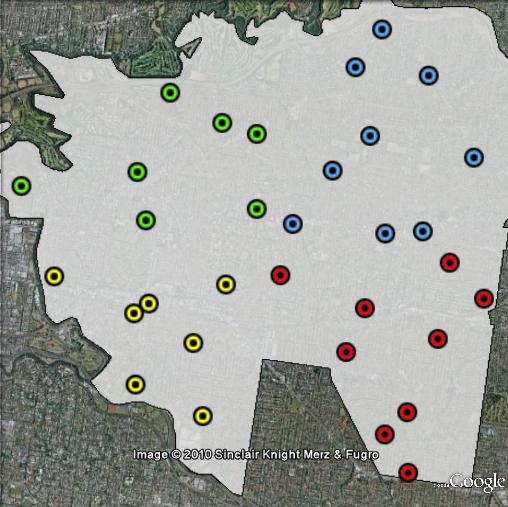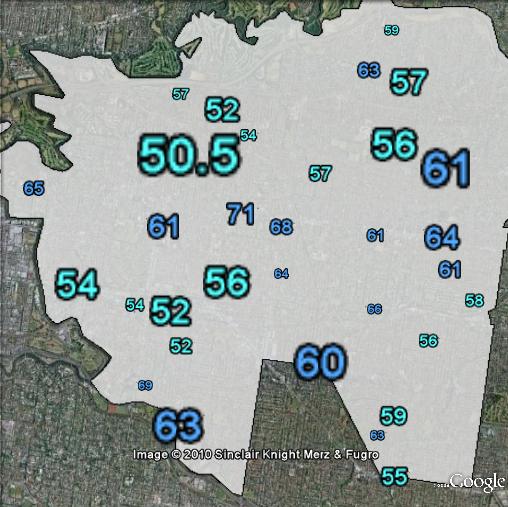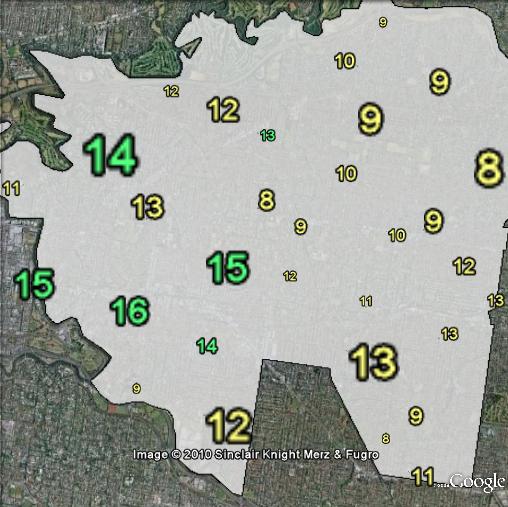LIB 9.5%
Incumbent MP
Petro Georgiou, since 1994.
Geography
Eastern suburbs of Melbourne. Kooyong covers most of the Boroondara council area, including the suburbs of Hawthorn, Kew, Camberwell, Canterbury and Balwyn.
History
Kooyong is an original federation electorate, and has always been held by conservative parties, by the Free Trade Party for the first eight years and by the Liberal Party and its predecessors since 1909. It was held from 1922 to 1994 by only three men, all of whom led the major conservative force in federal politics.
The seat was first won in 1901 by Free Trader William Knox. He was re-elected in 1903 and 1906 and became a part of the unified Liberal Party in 1909. He won re-election in 1910 but retired later that year after suffering a stroke.
The 1910 by-election was won by Liberal candidate Robert Best. Best had previously served as a colonial minister and a Protectionist Senator from 1901 to the 1910 election, when he lost his seat in the ALP’s majority victory, and had served as a minister in Alfred Deakin’s second and third governments. Best returned to Parliament, but didn’t serve in Joseph Cook’s Liberal government or Billy Hughes’ Nationalist government.
At the 1922 election, Best was challenged by lawyer John Latham, who stood for the breakaway Liberal Union, a conservative party running to personally oppose Billy Hughes’ leadership of the Nationalist Party. Despite winning the most primary votes by a large margin, Best lost to Latham on Labor preferences.
John Latham was elected as one of five MPs for the breakaway Liberal Party (two of whom had previously been Nationalist MPs and retained their seats as Liberals in 1922). The Nationalists lost their majority due to gains for the Liberal Party and Country Party, and were forced to go into coalition, and the Country Party demanded Billy Hughes’ resignation as Prime Minister. With Stanley Bruce taking over as Prime Minister, the five Liberals, including Latham, effectively rejoined the Nationalist Party, and Latham won re-election in 1925 as a Nationalist.
Latham served as Attorney-General in the Bruce government from 1925 to 1929, when the Nationalists lost power, and Bruce himself lost his seat. Latham became Leader of the Opposition, but yielded the leadership to former Labor minister Joseph Lyons when they formed the new United Australia Party out of the Nationalists and Labor rebels. Latham served as the unofficial Deputy Prime Minister in the first term of the Lyons government (when they governed without the need for support from the Country Party), before retiring at the 1934 election. Latham went on to serve as Chief Justice of the High Court from 1935 to 1952.
Kooyong was won in 1934 by Robert Menzies. Menzies had been elected to the Victorian state parliament in 1928 and had served as Deputy Premier in the United Australia Party government from 1932 to 1934. He was immediately appointed Attorney-General in the Lyons government. He served in the Lyons government until 1939, when he resigned from the Cabinet in protest over what he saw as the government’s inaction. This was shortly before the death of Joseph Lyons in April 1939, which was followed by the UAP electing Robert Menzies as leader, making him Prime Minister.
Menzies’ first term was rocky, with the Second World War being declared in September 1939. He managed to retain power with the support of independents at the 1940 election, but after spending months in Europe on war strategy in 1941 he returned home to opposition within the government, and was forced to resign as Prime Minister and UAP leader. He was replaced as leader by Country Party leader Arthur Fadden, who was followed soon after by Labor leader John Curtin.
Menzies worked in opposition to reform the conservative forces, who suffered a massive defeat at the 1943 election. In 1944 and 1945 he put together the new Liberal Party, which took over from the moribund United Australia Party and a number of splinter groups. He led the party to the 1946 election and won power in 1949.
Menzies held power for the next sixteen years, retaining power at elections in 1951, 1954, 1955, 1958, 1961 and 1963, and retiring in January 1966.
The 1966 Kooyong by-election was won by Andrew Peacock, then President of the Victorian Liberal Party. Peacock rose to the ministry in 1969 and served in the ministry until the election of the Whitlam government in 1972. He served as a senior frontbencher during the Whitlam government and became Minister for Foreign Affairs in the Fraser government in 1975. He moved to the Industrial Relations portfolio in 1980, but resigned from Cabinet in 1981 due to supposed meddling in his portfolio by the Prime Minister. He launched a failed challenge to Fraser’s leadership and moved to the backbench, although he returned to Cabinet in late 1982, a few months before Malcolm Fraser lost power.
After the 1983 election, Peacock was elected leader, defeating John Howard, who had served as Deputy Leader of the Liberal Party for the last few months of the Fraser government. Peacock led the party into the 1984 election, reducing the Hawke government’s majority. With rising speculation of a leadership challenge from Howard (still deputy leader) in 1985, he attempted to replace Howard as deputy leader, but the party room re-elected Howard. This caused Peacock to resign as leader and Howard was elected Leader of the Opposition. Howard led the Liberal Party to a bigger defeat in 1987. Howard was challenged by Peacock in 1989, and Peacock led the Liberal Party to the 1990 election. Despite winning a majority of the two-party preferred vote, Peacock didn’t win enough seats, and he resigned as leader immediately after the election.
Peacock remained on the frontbench under the leadership of John Hewson and Alexander Downer, and retired in 1994. Peacock was appointed Ambassador to the United States upon the election of the Howard government in 1996, and served in the role until 1999.
Kooyong was won at the 1994 by-election by Petro Georgiou, the State Director of the Victorian Liberal Party. Georgiou was a former advisor to Malcolm Fraser and a key proponent of multicultural government policies. Georgiou’s main opposition came from Greens candidate Peter Singer, due to the absence of a Labor candidate. Singer managed 28% of the primary vote, which remained a Greens record until the 2009 Higgins by-election, but it wasn’t enough to seriously challenge the Liberal hold on Kooyong.
Georgiou positioned himself strongly as a moderate within the Liberal Party and despite his impeccable credentials in the Liberal Party and as a policy advisor, he never held a frontbench role in the Howard government. He was openly critical of the Howard government’s refugee policies in the final term of the Howard government. He faced a strong preselection challenge in 2006, but managed to win more than two thirds of votes in the preselection. He managed to win re-election in 2007 with practically no swing against him, despite the Liberals suffering large swings across Australia.
Candidates
- Steve Hurd (Labor)
- Des Benson (Greens)
- Josh Frydenberg (Liberal)
- John Laidler (Family First)
Political situation
This seat is very safe for the Liberal Party. Having said that, Georgiou’s independence from the Liberal Party probably protected him from a swing against him in 2007, and that general anti-Liberal swing could kick in against Frydenberg in 2010.
2007 result
| Candidate | Party | Votes | % | Swing |
| Petro Georgiou | LIB | 45,172 | 55.14 | +0.48 |
| Ken Harvey | ALP | 24,599 | 30.03 | +1.02 |
| Peter Campbell | GRN | 9,686 | 11.82 | -0.72 |
| John Laidler | FF | 1,261 | 1.54 | +0.16 |
| David Collyer | DEM | 1,056 | 1.29 | -0.56 |
| Pierre Curtis | CEC | 154 | 0.19 | -0.37 |
2007 two-candidate-preferred result
| Candidate | Party | Votes | % | Swing |
| Petro Georgiou | LIB | 48,775 | 59.53 | -0.05 |
| Ken Harvey | ALP | 33,153 | 40.47 | +0.05 |
Booth breakdown
Booths in Kooyong have been divided into four areas according to key suburbs: Balwyn in the northeast, Canterbury-Camberwell in the southeast, Hawthorn in the southwest and Kew in the northwest.
The Liberal Party won a majority in all areas. Georgiou won over 60% in the Balwyn area, just under 60% in Canterbury-Camberwell, and around 57% in the western parts of the seat. The Greens polled most highly in the Hawthorn area, polling over 14%, compared to less than 9% in the Balwyn area in the other corner of the seat.

| Voter group | GRN % | LIB 2CP % | Total votes | % of votes |
| Balwyn | 8.94 | 60.58 | 18,347 | 22.39 |
| Hawthorn | 14.07 | 56.80 | 15,316 | 18.69 |
| Canterbury-Camberwell | 11.35 | 59.93 | 14,617 | 17.84 |
| Kew | 12.20 | 57.74 | 14,126 | 17.24 |
| Other votes | 12.85 | 61.69 | 19,522 | 23.83 |




“The Liberal Party is running Josh Frydenberg, a former Howard advisor who challenged Petro Georgiou for preselection in 2006.”
And that’s pretty well all you need to know about the direction the Liberal Party is taking.
Does anyone know of Singer’s current involvement with the Greens? I know that he’s currently teaching at Princeton (I’m pretty sure it’s Princeton). He would be a very very formidable candidate in certain seats.
John Latham was the only avowed atheist ever to lead a major Australian party. History will probably judge Peacock better than observers at the time did.
What about Hawke? Or Mark Latham?
Hawke was an agnostic. I’m pretty sure Latham was too.
“Having said that, Georgiou’s independence from the Liberal Party probably protected him from a swing against him in 2007, and that general anti-Liberal swing could kick in against Frydenberg in 2010.”
Dunno about that. Peter Costello didn’t cop much of a swing against him in Higgins, either. I think the lack of swing had more to do with
a) Inner city seats being volatile in the first place, and
b) The “doctors wives” effect already having taken a chunk out of the Lib vote in 2001 and 2004.
argh!
(a) should read “Inner city seats NOT being volatile in the first place”
Perhaps. Russell Broadbent is an outer suburb MP and fellow moderate and also had a neglible swing. It seems likely that there will be a swing to Labor in Kooyong (at least compared to the national average) because of the loss of a popular sitting member, regardless of his views. Of course this won’t change that Kooyong will remain safely Liberal.
Petro Georgiou and Russell Broadbent equally popular Liberal Parliamentarians who were unafraid to ‘stand up’ for a cause.
Petro will be missed, his invaluable contibutions were often unsung.
Josh Frydenberg should win the seat with 56-57% 2PP.
Some interesting numbers on the border of Kooyong and Chisholm from the 2007 election.
Surrey Hills West (Kooyong): 58.5% Liberal 2PP
Chatham (Kooyong): 55.6% Liberal 2PP
Balwyn North East (Kooyong): 60.6% Liberal 2PP
Surrey Hills (Chisholm): 51.3% Liberal 2PP
Mont Albert (Chisholm): 47.5% Liberal 2PP
Wattle Park (Chisholm): 42.0% Liberal 2PP
Elgar park (Chisholm): 49.9% Liberal 2PP
These aren’t cherry picked numbers. Very indicative of the dramatic change when crossing the border. And Surrey Hills/Mont Albert are very similar demographically to Chatham/Surrey Hills West. Best explanation of this is the popularity of Petro in the area. Still think Frydenburg will win though.
SMc
I think that’s more to do with the fact that Chisholm is a marginal Labor seat where Labor obviously puts in a huge effort, whereas Kooyong is a safe Lib seat where Labor would barely bother.
From my recollection, Chisholm wasn’t really considered “in-play” in 2007. I think it would be off-the-mark to say ALP put in a huge effort there.
My prediction: 2-3% swing to Labor.